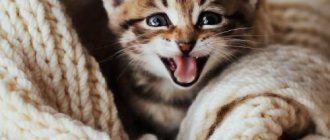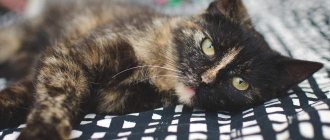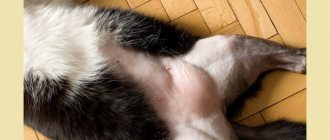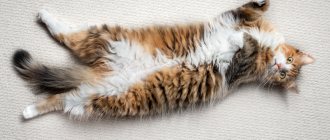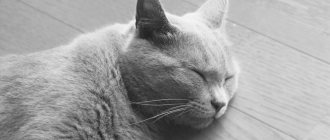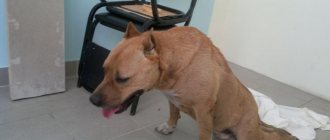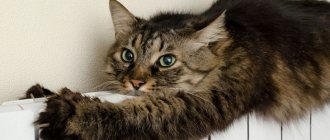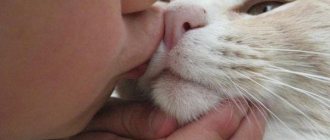10107Administration
2
If the owner notices that the cat’s paws are shaking, then it is necessary to urgently visit a veterinarian. This phenomenon should not be ignored. It also happens that a cat’s hind legs are shaking, but the front legs are not affected by the disorder. The tremors in the hind limbs that your cat suffers from will not go away on their own. If you start a violation, then there is a danger that gradually the paws, which at first only shake, will begin to fail, and the cat will simply end up half paralyzed, forced to lie down all the time. No owner would want such an outcome, and therefore, naturally, will make every effort to restore the normal state of the pet. It is important to know that when the paws shake, the trembling in them is not a cramp.
When asked why the owner sometimes notices tremors in the limbs of a kitten or an adult pet, the answer can be completely different, since the reasons range from harmless to pathological.
© shutterstock
Reasons why a cat trembles
Tremor or trembling in a pet is not always a sign of illness. If a cat is trembling, then it is almost impossible not to notice this state of the animal. There are several main reasons that can cause a pet to tremble in apparent absolute health:
- an animal's reaction to an external stimulus represented by cold. This reason is the most harmless, but can cause a number of quite serious consequences, including severe hypothermia of a pet. It is especially important to control the temperature in the room when keeping hairless breeds and cats with short hair. In cool weather, it is necessary to reduce walks with the animal to a minimum or completely eliminate its stay on the street;
- an animal's reaction to severe fright or any stressful situation. Quite often, this situation arises when there is a sudden change in diet, the appearance of strangers or unfamiliar animals in the house, as well as when being transported to a new place of residence. In this case, it is enough to eliminate all factors that provoke trembling as quickly as possible and calm the pet;
- reaction to a joyful event. Trembling in an animal can also cause quite positive emotions, including joy from the appearance of the owner or pleasure from games, affection and receiving favorite foods;
- reaction to sexual arousal. The appearance of fairly distinct trembling can be caused by a state of sexual arousal in a cat or a cat in heat. In almost all representatives of the cat family, all senses are very characteristically heightened and behavioral characteristics change greatly during the period of sexual arousal, therefore, it is advisable to sterilize or castrate animals not intended for breeding;
- natural processes. Actively occurring in the body of a sleeping pet, they can also be accompanied by trembling of the body and limbs.
Important! Particular attention is required to frequent, quite strong tremors of the body and limbs, which occur in a pet regularly and for no apparent reason.
In this case, it is necessary to deliver the cat to a veterinary institution as quickly as possible, where a full range of basic, most informative diagnostic measures will be carried out aimed at identifying the cause of the pathological condition.
Causes of body trembling
The tremor effect is caused by strong muscle tension in the animal.
The cat may be stressed and scared. The desire to quietly get close to a sparrow sitting nearby causes muscle tension and a silent gait. But after capturing the desired victim, relaxation sets in, and characteristic muscle tremors are observed. During sleep
When the temperature drops, the cat may experience discomfort, a desire to stay warm, and shivering stimulates heat production. An uncomfortable position also causes shaking. Another source is the period of puberty, the rut. The cat is trembling from a powerful release of hormones, anticipating a quick meeting with the female. This condition is absolutely normal and no help is required.
If periodic trembling of the limbs is observed, you should pay close attention to the animal’s diet. Perhaps there is a banal weakness due to lack of nutrients, malnutrition
Small kittens may suffer from rickets, bowed legs, trembling becomes evidence of weak bones, weakened muscle tone.
When the cat shakes, unsuccessfully trying to return to the optimal position, you should start sounding the alarm. The condition is atypical, plus convulsions, vomiting, fever are mixed in - there is definitely some kind of disease. The most dangerous thing for a cat’s life is rhinotracheitis. A disease that affects the respiratory and visual systems can quickly lead to paralysis of the respiratory center and death of the animal.
If the cat is trembling all over, experiencing obvious difficulties in moving, or other signs of illness are observed, you should seek veterinary help. The veterinarian will examine the cat, assess its internal and external condition, and prescribe qualified treatment. In the other described cases, it is enough to provide the cat with additional heat, eliminate drafts, and balance the diet.
A kitten's active sleep is not a reason to worry
Most of the speculation surrounding the concern comes from kitten owners. We dare to assure you that if your cat twitches in his sleep, but he is not yet 12-15 months old, this is normal. Don't worry if the kitten sleeps in an unnatural position or if its eyes are slightly open. The first is explained by the fact that kittens are not so demanding of comfort, the second is due to the presence of a third eyelid, a transparent film that protects the eye during sleep, even if it is open.
The kitten may twitch violently, roll over, and even meow after stress or active play. If the baby is sleeping and you notice that his paws are twitching, it means that the four-legged animal is walking or running in its sleep. Until 1.5–2 years of age, activity in the REM phase is absolutely normal and is explained by an incompletely formed nervous system.
The REM phase of sleep in kittens up to 6 months takes up about 80% of all sleep time. If you notice that your cat doesn’t startle in its sleep as often as before, you can draw conclusions about the strengthening of the nervous system and the maturation of the animal as a whole. The period of formation of the nervous system is very individual and depends on many factors. In outbred so-called native cats, it lasts up to 10 months; some purebred cats “remain children” for up to two years.
Why does a cat fall over on its side when walking: reasons
However, the list of medications for each case is individual, and the veterinarian draws it up based on the diagnosis. The same goes for aftercare.
Most neurologists recommend examinations every two weeks to monitor the progress of treatment. Secondary symptoms such as vomiting and dehydration should also not be ignored. Experience shows that cats recover faster after diseases of the peripheral nervous system.
Prevention of "shifty" eyes
It is impossible to formulate a specific system of preventive measures for nystagmus, because There are many reasons, including congenitality. The only thing we can advise is to avoid poisoning your cat with lead and other toxins. In addition to Siamese cats, cats with albinism are predisposed to this disease, keep this in mind. Some kittens under one year of age may exhibit nystagmus, but this is very rare and will go away soon.
Category Cat diseases.
Ataxia in cats is a pathology of motor activity characterized by a lack of coordination of muscle movements, coordination and loss of orientation in space.
Most often it is genetic in nature, but can be acquired as a result of a severe form of group B hypovitaminosis or cerebellar injury. What is characteristic is that the animal remains strong, it is simply more difficult for him to maintain balance and the sequence of each action.
This neurological disorder does not have any age, breed or gender restrictions and can be diagnosed almost from birth, as soon as the kitten begins to move. It is practically incurable.
When to contact a veterinarian
If the tremor of the cat’s body, head or limbs is not caused by a physiological condition, then it is very important to carry out an extensive examination of the pet. The following fairly common pathologies require timely and correct treatment:
- trembling of the limbs caused by herpes virus infection or rhinotracheitis of the animal. You can independently identify the pathology in the presence of such basic symptoms as the presence of purulent discharge from the nasal cavity and eyes, as well as cough, vomiting and fever;
- When there is a helminthic infestation or cystitis, the pet shakes its limbs very often, which allows the animal to reduce the feeling of itching and pain. Among other things, tremor occurs due to severe discomfort when urinating;
- systematic or periodic twitching of a cat's head is most often one of the symptoms when an animal is affected by otodectosis or ear scabies. In this case, in addition to twitching, scratching of the affected ear is noted. Visual inspection allows you to see damage to the outer ear and ear canal. This disease requires urgent medical intervention;
- By frequently twitching the head, a pet may be trying to get rid of discomfort due to otitis media or accumulated wax. In the first case, delay in treatment can cause lifelong deafness in the animal or complications in the form of severe organic damage to the hearing organs;
- a cat is capable of shaking its head frequently and quite actively in case of functional disorders, including pathologies of the liver, kidneys and respiratory system. Severe tremor in this case, as a rule, indicates the presence of irreversible damage to internal organs.
Trembling in the croup area of a cat or the presence of generalized tremor in a pet may indicate the presence of various lesions in the spine, which are most often represented by compression fractures, tumors and deformation of the intervertebral discs, as well as spinal canal stenosis. The most severe organic lesions are also accompanied by weakness in the lower extremities and trembling of the animal during any attempt to stand on its feet.
We suggest you read: How to find out the weight of a cow or calf without scales? Measurement table
The rapid development of the disease and the lack of adequate treatment provokes the development of paralysis and sometimes the death of the animal. In some cases, it is possible to stop the attack fairly quickly, but most often the process of treating severe pathologies is lengthy and quite expensive.
If the tremor is accompanied by weakness and severe pain, in which the animal meows loudly and plaintively, and arches its entire body, then it is necessary to exclude poisoning and the entry of any sharp object into the digestive system that can cause severe damage to the mucous membrane, as well as gastric or intestinal bleeding.
Noticing that a cat is twitching in its sleep, the owner may be concerned about the well-being of the pet. If we are talking about an adult cat, suspicions are far from unfounded. Let's figure out why cats twitch in their sleep and what it may indicate if a cat twitches too much.
It was cats, or rather, their dreams, that made it possible to prove to the whole world that animals also plunge into the world of dreams. Moreover, scientists suggest that our pets' dreams are much richer and more dynamic than ours. It all started when doctors began to study the phases of human sleep. To confirm their assumption that healthy people lose the ability to move during REM sleep, an experiment was conducted on a group of cats.
All animals had a small area of the brain removed, which was responsible for muscle atonia in the REM phase of sleep. After the animals were fully rehabilitated, the scientists' suspicions were corrected. The observed cats stood on their paws, walked confidently, and turned their heads, as if watching someone. While in a state of sleep, cats sniffed and turned their ears. The experiment proved that cats see, hear and touch dreams.
https://www.youtube.com/watch?v=bBlDWl9n6mc
These are the main reasons why a kitten may be shaking. If the baby feels generally fine, and there are no other alarming symptoms, and the tremor goes away as quickly as it started, there is no need to worry too much, but it is worth watching the animal.
Paws tremble most often when the cat’s body is infected with the herpes virus or when loryngotrocheitis develops. The main symptoms of such pathologies, in addition to the fact that the cat’s hind legs are trembling, are:
- nasal discharge;
- cough;
- temperature increase;
- lethargy.
Trembling in the paws may also occur due to advanced helminthiasis or cystitis. In such a situation, paw trembling is aimed at relieving discomfort in the abdominal cavity. Treatment for the appearance of pathological tremors should be carried out urgently. Postponing it for days, and moreover, for a month, is unacceptable, as this may pose a threat to the life of the pet. The help of a veterinarian will be necessary.
The reasons that lead to trembling in an animal are numerous.
These are both external factors (toxic substances) and internal diseases.
Trembling limbs
Trembling in the limbs of a pet can be caused by a herpes virus infection or rhinotracheitis of the animal. The main symptoms of this disease are purulent discharge from the nose and eyes, cough, vomiting, and fever.
Head shaking
Quite a few reasons can lead to systematic or periodic twitching of an animal’s head. Frequent twitching may be a sign of otodectosis or ear scabies. In addition to twitching, you can observe how the animal often scratches the affected ear, literally plunging its paw into the ear canal and injuring the tissue. At the same time, the cat may meow pitifully.
Systematic head twitching can be a sign of otitis media, while the cat’s ear hurts and she won’t let it be touched. Or it may be evidence of the formation of sulfur plugs.
Head twitching may indicate liver failure, acute disruption of the respiratory system and even the kidneys. If the functioning of internal organs is disrupted, the disease occurs with a characteristic clinical picture of a particular disorder. Tremor appears already at the stage of organ failure.
Encephalitis, the use of certain medications, vestibulopathy, cerebellar pathologies, and traumatic brain injuries can cause tremors and even seizures.
Lesions of the spine (compression fractures, tumors, deformation of intervertebral discs, spinal stenosis) can lead to weakness of the lower extremities and trembling when the animal tries to stand on its feet. With further development of the disease, paralysis occurs.
Neuromuscular diseases, degenerative neurological pathologies, myelin deficiency, metabolic pathologies and even poisoning by toxins (for example, organophosphates) can cause severe tremors throughout the animal's body.
Caring cat owners carefully monitor their pet’s behavior, noticing in time the slightest changes in their behavior, indicating problems in the animal’s well-being. That is why any uncharacteristic action can serve as a symptom of an illness.
What to do if your cat is shaking? This question worries many breeders who are faced with this sign of a pet’s ill health. Firstly, we can advise you to pay attention to the frequency and intensity of this manifestation. How often does a cat shake? How long does it last? Does the animal's entire body shake or just a certain part of the body?
Are there any additional symptoms of the disease - increased body temperature, hair loss, decreased activity? The answers to all these questions will allow you to establish the truth and suggest what exactly is bothering your pet. However, in many cases, you should not rely on your own observation and basic knowledge of veterinary medicine; you should seek help from a specialist as soon as possible in order to diagnose the disease and prescribe appropriate treatment.
So, if a cat is shaking, then this may be a manifestation of emotions - both positive and negative. The animal may feel chills from cold, fear or extreme joy. In this case, the cat is not shaken for too long, after which the animal continues to behave naturally. The urge to naturally defecate or urinate can also cause your cat to tremble.
Most often this sign is observed in kittens. During puberty, a cat may also shake, and in an adult cat, trembling may be observed before estrus. Sterilizing your cat will eliminate this sign forever. However, if after the operation the cat continues to shake, this is a reason to seek help from a veterinarian.
After sterilization, the cat may shake due to the presence of a blanket on the body. The cat instinctively tries to get rid of a foreign object on its own body, so it periodically shakes, trying to throw off the blanket. Veterinarians usually warn breeders about this after the operation.
We suggest you read: The cat has a large belly on the sides Moscow, why does the cat have a hanging belly?
A lack of vitamin B in a cat’s body can also cause the pet to periodically tremble. Veterinarians advise adding brewer's yeast to animal feed in order to prevent vitamin B deficiency. It is not difficult to find this remedy in veterinary pharmacies. A cat may twitch in its sleep - this is a normal phenomenon caused by neurochemical reactions in its body during a state of "oblivion."
Trembling limbs
The main reasons for squatting on your hind legs
Cats are considered graceful animals; their gait in a healthy and calm state is always imposing and relaxed. But some owners notice that the cat squats on its hind legs while walking. Among the most common reasons for this behavior are the following negative factors:
- Spinal cord injury. It often happens in cats that have experienced falls from great heights, for example, from a balcony. The spinal column can also be injured during an unsuccessful jump, during which the animal hits furniture (corners of cabinets, tables, doors). Even a seemingly insignificant blow can lead to the development of pathologies in the lumbar spine. Injury to the post is accompanied by a number of additional signs, including incontinence of urine and feces, complete or partial paralysis of the forelimbs, weakness, uncertainty in movements, a constantly lowered tail and lack of tension in it, and the inability to perform maneuvers. Spinal diseases can be not only acquired, but also congenital. Anomalies of fetal development in cats are common. Much depends on the breed. For example, in cats such as the Maine white-tail, vertebral arches are often not fused. In any case, to keep your pet active, an X-ray of the spine or an MRI should be done. In severe cases, the cat may be required to undergo surgery and wear special wheelchairs for mobility;
- Diseases of the circulatory system. If a cat squats on its hind legs when walking, then this may be a lack of blood volume flowing to the limbs. The causes are blood clots in the system or heart disease. Blood clots are very dangerous for the life of an animal and can cause death. Paralysis, lack of movement in the limbs, severe pain during which the cat meows, difficulty walking, and an increase in both local and general temperature are very often observed. Symptoms of heart failure include coughing, loss of appetite, weight loss, difficulty breathing, and a feeling that the cat is not getting enough air. Activity decreases to conserve strength. For treatment, medications that thin the blood, dilate blood vessels, and strengthen the heart muscle are indicated. In severe cases, the doctor may prescribe surgery to remove the blood clot. To prevent blood clotting, it is necessary to introduce a large amount of water into the cat’s diet. On average, an adult drinks up to 120 ml per day. This volume also includes liquid food;
- Middle ear diseases. In the middle section of the ear there is a vestibular apparatus, thanks to which the animal orients itself in space, and also coordinates movements. The cause of the inflammatory process is infections, parasites, fungi and bacteria that have penetrated into the middle or internal part of the organ. Ear mites are very dangerous, as they quickly fill all parts of the ear. Problems also develop due to the formation of benign polyps, injuries received, and the ingress of foreign bodies. As a result, the cat falls on its hind legs.
Causes of trembling in a cat
The cat was simply frozen. It would seem that cats can really suffer from the cold, since they can be outside even in the winter? However, in fact, cold is the worst enemy for all living organisms. An animal that has become hypothermic can not only catch a cold, but also become seriously ill.
A problem of this nature can be solved in the following way:
- Do not let the animal go outside in winter.
- Buy clothes for cats in specialized stores, or make them yourself.
If a cat, coming from the street, lies down on the floor, on the sofa, or somewhere else, and at the same time trembles strongly, he is simply very cold during a walk. It is also worth keeping an eye on the animal and during this very walk, it may begin to shake while still on the street.
The cat became scared. The person who believes that cats are the most fearless animals is deeply mistaken. They may show this with all their imperturbable appearance, attacking the feet of their owners, damaging the owner’s property, however, in the very depths of their souls, these animals are very vulnerable and timid creatures: you can scare a cat as easily as possible.
Due to experiencing severe fright, or a stressful situation, which, for example, may be associated with a change of residence, a change in food, or the appearance of a stranger in the house (in fact, there are a huge number of reasons). In this case, a nervous shock may occur in the cat’s body, the result of which will be trembling or nervous chills.
The cat begins to literally shake with fear. What to do in this case? It would be most advisable to try to eliminate the cause in the form of that same provoking factor. The owner will have to try to calm his beloved pet, stroke it, caress it. Every person knows that fear and stress can be eliminated through the use of positive emotions.
If such a cat's tremors are ignored, in the future such an action may lead to a change in the cat's behavior, which may result in habits that irritate the owner.
The cat experiences joy and positive emotions. The pet may tremble while lying down from an excess of positive emotions. The mustachioed man could miss him very much during the whole day of absence of the owner of the house. And when the owner comes home, the cat rushes to climb onto his lap and settle down there comfortably in a ball or stretched out to his full cat height.
Trembling when lying down in this case means exclusively a test of pleasure from the fact that its owner is near him
The cat lies down on the floor after eating and begins to tremble. Veterinarians say that a full stomach can bring a cat to this state; the animal’s muscles simply contract.
The cat is experiencing sexual arousal. When an animal is in such a state, it may experience a tremor of the whole body, which in turn is due to the fact that the cat’s senses are very heightened at a given moment in time and its excitement reaches its extreme measure. In the event that the owner does not intend to breed cats, the correct way to get rid of tremors of this nature will be castration of the mustachioed one.
If the cat owner has determined that the cat has any of these reasons, then there is no need to worry in this case: the cat will calm down and the trembling will go away by itself.
Pathologies
It is necessary to diagnose the pathology in time.
Tremor can accompany the development of pathologies, so owners should closely monitor their pet and seek advice from a specialist.
Possible pathologies:
- cat flu;
- panleukopenia;
- rhinotracheitis;
- calicivirus;
- central nervous system disorder;
- kidney damage.
It is necessary to diagnose a possible pathology in time and take all measures to eliminate it.
When should you worry?
If a cat's paws twitch in its sleep, this is not always a cause for alarm. You should keep an eye on your pet. You need to observe not so much in a dream as at the moment of awakening. The state of the animal is immediately visible: if the cat is happy, she has the perky look of a hooligan or, on the contrary, the mysterious arrogant look of an empress, she stretches and yawns, purrs briefly and abruptly.
You should be concerned if your cat twitches too often during sleep. When your pet looks unhappy, tired and lethargic when waking up, you should immediately contact a veterinarian.
Doctors' help is also required in cases where a cat twitches its paws in its sleep and then wakes up sweaty and with wet fur. This is a symptom of internal problems in the body, which may be related to hormonal balance or kidney function.
Persians who eat dry food often suffer from kidney failure and urolithiasis. Persian cats prone to such ailments always first begin to twitch and sweat, and only after some time do characteristic symptoms appear - changes in the concentration, color and smell of urine.
When observing a sleeping twitching cat, you need to carefully touch it, trying not to wake the pet. This should be done in order to understand whether the animal has a cramp - contraction of muscle fibers. It is impossible to determine this visually. If your pet's body or legs are cramping, you should immediately consult a doctor.
We suggest you read: Causes of tremors in cats. Why are my cat's back legs shaking?
Symptoms of paralysis of the limbs
Symptoms of the disease appear depending on the cause of paralysis.
- With inflammation of the spine and spinal cord, weakness in the limbs occurs with possible subsequent failure. The animal may have bloating, paralysis of the rectum and bladder. The cat may begin to lick and bite its back paws. When trying to move, he feels severe pain.
- Fibrocartilaginous embolism is characterized by sudden pain. The cat exhibits apathy, there is no sensitivity in the area of the hind legs and lower back. If the animal does not react to stimuli at all, the prognosis is unfavorable.
- Arterial thromboembolism complicates the work of the heart, causing its failure. When palpating the limbs, the cat feels pain. Cyanosis is visible on the paw pads, and the limbs become cold. The animal's breathing becomes heavier and shortness of breath appears.
- Fibrosis of the heart muscle at the initial stage practically does not manifest itself in anything other than numbness of the hind limbs. Subsequently, disturbances in heart rhythm and pulse are observed.
- After a stroke, the animal will have difficulty moving, falling on its side. The ability to eat, swallow and even breathe normally is complicated. In some cases, the cat will be in a state of shock and not respond to stimuli.
With any of these diseases, you may notice the following signs in your kitten:
- the gait becomes wagging with the hind legs affected;
- the animal moves slowly and uncertainly, as if drunk;
- the hind legs move apart;
- frequent squatting on the hind legs;
- dragging the paws without lifting them off the floor.
A symptom of paralysis in cats can be dragging their paws without lifting them off the floor.
If you notice at least one of the symptoms, immediately contact a clinic or private veterinary office. Inaction or delayed treatment can cost the animal its health, and possibly its life.
What else causes twitching?
A sleeping cat may twitch for a variety of reasons. In order for the doctor to be able to narrow down the range of possible sources of this phenomenon, careful observation of the pet is required.
The presence of muscle spasms, severe convulsions, and contraction of the limbs is always a signal of a serious illness. Unlike simple fingering and reflexive twitching of the paws, this condition is not caused by a dream or stress.
If a cat, the causes of this condition may be hidden in the reality around it, that is, stress may be the source of the twitching. Each animal has its own stress tolerance threshold, just like humans. Some cats are extremely emotional and very susceptible to the slightest negativity. For such animals, a rude word, inattention from the owners or being thrown aside, even a potty that is not cleaned in a timely manner and a bowl that is not washed can cause anxiety and nervous breakdown.
Siamese and Burmese are the most inclined to dramatize everything that happens around them, but Persians are cats with a stable nervous system.
Animals endowed with sociable character traits, but forced to spend the whole day locked up alone, are also prone to stress and psychological distress. For such a cat, the owner’s return from work is a great and long-awaited joy; if a person shows dissatisfaction, the animal is sincerely upset and does not understand what it has done wrong. Several such cases lead the pet to chronic stress, which subsequently develops into prolonged depression.
How to treat tremors and seizures in cats?
When trying to figure out how to cure tremors in a cat, the animal owner often acts by analogy with human diseases. This is the wrong way, because... The organisms of cats and humans are structured differently. Sometimes the owner, without realizing this, begins self-treatment. At the same time, he wastes time: the effect of therapy is not achieved, the signs of the disease are sometimes erased, but the disease itself progresses.
You need to understand that tremor in a cat can be treated only after the cause is determined. Without examination, laboratory and instrumental studies, an accurate diagnosis cannot be made.
Further prognosis depends on the type of pathology. Sometimes a course of vitamins is enough to completely restore the conduction of nerve impulses. However, the disease often cannot be treated. Each specific case requires separate consideration.
Rate and share!
What causes seizures?
When figuring out why cats twitch in their sleep, doctors identify specific diseases, including:
- non-purulent meningoencephalitis;
- cerebral ischemic encephalopathy;
- viral infectious peritonitis;
- toxoplasmosis;
- hyperparathyroidism;
- helminthiasis;
- ticks and fleas;
- excess medications or other drugs and additives in the blood;
- microstroke;
- lack of vitamin B;
- urolithiasis disease;
- renal failure;
- anemia.
Each of these diseases is very serious, but the most dangerous of them are meningoencephalitis, encephalopia and peritonitis.
About meningoencephalitis
Non-purulent meningoencephalitis is most often diagnosed by doctors in a situation where a cat twitches in its sleep. The difference between this disease and ordinary encephalitis and classic meningitis is the absence of accumulations of pus inside the skull. The pathogenesis itself combines some processes characteristic of both diseases. This disease is an inflammation of the membranes of the brain and itself. It occurs most often in the form of complications and consequences of such ailments as:
- viral infections;
- hepatitis;
- leptospirosis;
- plague;
- ascariasis and mycosis.
In addition, the disease develops after bruises, various injuries to the skull and spine, and prolonged sepsis. Cramps during sleep are one of the earliest symptoms of this disease. But if you consult a doctor, your pet’s treatment will be successful and quickly enough.
About encephalopathy
Cerebral ischemic encephalopathy is a softening of certain areas in the brain. The exact causes of this disease are unknown to veterinarians, and the accompanying symptoms vary significantly in different animals.
Without treatment, a pet with such a disease will inevitably degenerate completely, losing not only individual personality traits, but also basic skills. This doesn't just apply to maintaining hygiene. For example, a cat may forget how to walk or eat.
About peritonitis
Viral infectious peritonitis is in many ways similar to HIV. This is a disease that affects the cat's immune system. In a neglected state, the animal has virtually no chance of survival.
Infection with this virus occurs:
- nutritionally, that is, through objects, food, contact of the tongue with dirty human hands;
- by airborne droplets.
In the early stages, the disease is often completely asymptomatic, with the exception of only one sign - the cat twitches in its sleep. This disease is extremely dangerous. The sooner it is detected, the greater the chance that the pathogenesis can be stopped or slowed down.
Types of ataxia
Ataxia is divided into several types, depending on the affected area:
- Sensitive. Affects the cat's ability to bend and straighten its joints. Chances of cure only with the earliest possible diagnosis;
- Cerebellar. It can be static (loss of balance) or dynamic (impaired movement). It starts with small manifestations of awkwardness and maintaining balance. In the case of a genetic factor, it is incurable; in the case of a traumatic cause, the chances of recovery are real;
- Vestibular. It starts with all movements becoming slow and very careful. At later stages, the body tilt changes to the left or right, and the animal stops moving straight.
What is the difference?
It is quite difficult to independently determine the difference between neurosomatic twitching and symptoms of an internal disease. The likelihood of an error is very high, therefore, if twitching of the body or limbs of a cat occurs regularly during rest, it is necessary to examine the animal.
The defining difference in the causes of twitching is considered to be the presence of a cramp. This means not only twisting of the limbs or body, in which the cat wakes up and screams, but also a slight hardening of the muscle fibers. The manifestation of emotional experiences, as a rule, is not accompanied by the appearance of stiffness in the muscles. That is, if a cat is upset and “runs around in its sleep,” its body and paws will be soft.
However, the causes of twitching are often mixed, since the sick animal perceives everything around it quite acutely.
What to do?
If a sleeping cat twitches regularly, the first thing to do is contact a veterinarian.
The immediate actions of a person during twitching determine the intensity of the manifestations and their characteristic features. If the cat continues to sleep, there is no need to wake it. In the same situations, when the animal’s muscles are cramped by a strong cramp, the pet needs to be helped - wrapped in a blanket or blanket, carried in your arms, and calmed down.
An epileptic seizure deserves special attention. This condition in a cat is not always accompanied by profuse salivation, as in humans; sometimes there is no saliva. The owner’s actions in this situation should be completely similar to how they behave around people during an epileptic attack.
If the animal's jaws are tightly closed, there is no need to unclench them - this can cause a fracture. The cat needs to be placed on its side and held in place, since the pounding body moves, that is, the pet can seriously hurt itself against a wall, furniture or something else. At the end of the attack, the cat should be calmed down and consult a doctor without delay.

